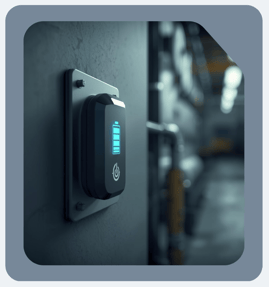

How eDRX and PSM Extend Battery Life in LTE-M and NB-IoT Devices
Low-power wide-area (LPWA) technologies like LTE-M and NB-IoT are transforming how connected devices operate. They enable smart meters, asset trackers, and sensors to remain online for years while consuming minimal energy. This evolution drives the low power IoT revolution, allowing devices to function efficiently without constant human intervention or battery replacement.
At the core of this shift are two essential features standardized by 3GPP and detailed in ETSI TS 127.007—Extended Discontinuous Reception (eDRX) and Power Saving Mode (PSM). Introduced in earlier releases, these mechanisms have been refined through 3GPP Releases 13 to 19 technical specifications, improving battery life, network efficiency, and scalability for massive IoT deployments. Understanding how they work and complement each other is essential for developers, network operators, and enterprises building smarter, sustainable IoT solutions.
What is Power Saving Mode (PSM)
Power Saving Mode allows an IoT device to enter a deep sleep for long periods while staying registered with the network. It is designed for devices that do not need constant communication and can remain offline for extended periods without affecting their function.
During PSM, the device shuts down most of its activity to conserve energy, but it maintains its network registration. This means it does not need to perform a full network re-attachment when it wakes up, which reduces signaling and saves additional power. Depending on the configuration, devices can remain in PSM for minutes, hours, or even hundreds of days. Under 3GPP specifications, a device can stay asleep for up to 400 days before the network removes it from registration—ideal for applications where the device only wakes when something important happens.
This behavior aligns with the GSMA IoT Device Connection Efficiency Guidelines, which recommend minimizing unnecessary signaling and encouraging long sleep cycles for devices that transmit infrequently. Event-driven and long-duty-cycle devices benefit the most from this.
For example, a residential or commercial security alarm may stay in deep sleep for months, waking only when it detects an intrusion. Remote industrial sensors can check in weekly unless they observe abnormal conditions. In logistics, asset trackers often sleep for extended periods while goods sit in storage, only waking when motion is detected or a scheduled report is due. Even automotive telematics units leverage PSM when vehicles remain inactive, preserving battery life while retaining the ability to report when necessary.
By allowing devices to stay registered while remaining dormant, PSM enables years of operation on a single battery—making it one of the most impactful power-saving features in LTE-M and NB-IoT networks.
What is Extended Discontinuous Reception (eDRX)
Extended Discontinuous Reception (eDRX) allows an IoT device to reduce how often it listens for incoming messages from the network, conserving energy while still maintaining periodic reachability. eDRX is primarily supported on 4G LTE-M and NB-IoT networks, where devices can extend their “listening” intervals from seconds to many minutes.
During an eDRX cycle, the device becomes temporarily unreachable. Depending on the configuration, this unreachable window can last 30 to 40 minutes or even longer, giving the device significant power savings while still providing predictable opportunities for the network to deliver messages. This behavior is especially useful in applications where the device does not need immediate downlink communication but must still receive updates occasionally.
For example, a connected asset tracker may only need to listen for network commands every half hour while preserving battery during periods of inactivity. A smart streetlight controller might check for instructions once an hour while the rest of the time remains in an energy-saving state. Industrial monitoring equipment can also rely on eDRX when it requires periodic configuration updates but does not need to be constantly reachable.
By enabling configurable listening intervals, eDRX gives IoT developers the flexibility to balance power consumption and responsiveness—ideal for devices that require occasional communication without the constant overhead of staying online.
Comparison of eDRX and PSM with 3GPP Release Reference
The table below summarizes key differences between eDRX and PSM and shows their evolution across 3GPP Releases 13–19, including the latest optimizations.
|
Feature |
Power Saving Mode (PSM) |
Extended Discontinuous Reception (eDRX) |
|
Purpose |
Deep sleep to maximize battery life |
Periodic listening for network messages |
|
Network Reachability |
Not reachable during sleep |
Partially reachable during paging cycle |
|
Battery Consumption |
Extremely low |
Low to moderate (configurable) |
|
Ideal Use Case |
Devices with infrequent data transmission |
Devices requiring occasional downlink communication |
|
Configuration Range |
Minutes to days |
Seconds to hours |
|
Typical Applications |
Smart meters, environmental sensors, agricultural monitors |
Vehicle trackers, industrial control units, logistics tags |
|
Supported Technologies |
LTE-M, NB-IoT |
LTE-M, NB-IoT |
|
3GPP Release Reference |
13–19 (optimized in Release 19 for massive IoT) |
13–19 (enhanced in Release 19 for latency and power) |
3GPP Release 19, finalized in 2023, builds on previous releases to improve energy efficiency, device sleep behavior, and signaling reduction, making both PSM and eDRX even more effective for large-scale IoT deployments.
How eDRX and PSM Work Together
Using eDRX and PSM together allows IoT devices to optimize both energy efficiency and connectivity. PSM provides long-term sleep for devices with infrequent communication, while eDRX creates short listening windows for periodic network checks.
For example, a smart meter may rely mainly on PSM to conserve energy, waking only to report usage data. A logistics tracker could utilize eDRX to remain semi-reachable while traversing supply chains. Health monitoring devices may combine both, remaining dormant until a critical event triggers transmission.
This dual approach helps enterprises deploy devices that operate reliably for years, minimizing maintenance and battery replacement costs while maintaining the required connectivity.
Why eDRX and PSM Are Essential for Low Power IoT and constrained devices

Battery longevity is one of the biggest challenges in large-scale IoT deployments. Every second of unnecessary network activity drains energy and increases operational costs. eDRX and PSM address this challenge directly.
By reducing unnecessary signaling and optimizing sleep intervals, these features allow LTE-M and NB-IoT devices to communicate efficiently while extending battery life. Enterprises can deploy devices at scale with lower total cost of ownership and improved sustainability.
Industries such as utilities, transportation, logistics, and agriculture rely on these features to maintain performance while minimizing maintenance. Global standardization by 3GPP (Releases 17–19) and ETSI, combined with GSMA guidelines, ensures interoperability and reliable operation across devices and networks.
FAQ
What are some challenges when using eDRX and PSM?
While eDRX and PSM provide excellent power savings, there are practical limitations. Not all mobile network operators (MNOs) support these features fully, especially for roaming partners, which can limit effectiveness for devices on the move. These power-saving modes are most effective for static or predictable devices; dynamic devices, like moving vehicles, may not see the same benefits. Mission-critical or delay-sensitive applications that use protocols such as TCP or MQTT may encounter latency or reliability issues while the device is asleep. Additionally, when a device is in deep sleep, the network cannot deliver data until the device wakes up, which can be a constraint for applications requiring real-time communication.
What is the main difference between eDRX and PSM?
PSM enables devices to enter deep sleep for long periods to maximize battery life, whereas eDRX allows devices to periodically listen for network messages while still conserving power.
Can eDRX and PSM be used together?
Yes. Combining both features enables devices to achieve the best balance between responsiveness and energy efficiency, depending on communication needs.
Do all LTE-M and NB-IoT networks support these features?
Most networks do, particularly those implementing 3GPP Release 13 and newer, with Releases 17–19 providing the latest optimizations for energy efficiency, latency, and large-scale deployments.
Which devices benefit most from these features?
Devices that transmit small amounts of data at predictable intervals, such as smart meters, asset trackers, and industrial sensors, see the greatest benefit.
How does Velos IoT support eDRX and PSM?
Velos IoT’s Nomad Connectivity Management Platform enables customers to manage global SIM and eSIM deployments efficiently. It supports LTE-M and NB-IoT power-saving features, including eDRX and PSM, allowing enterprises to deploy devices that run longer, use less energy, and maintain reliable connectivity across carriers and regions.
Sources
- 3GPP TS 23.682 & TS 27.007 (Releases 17–19) – Specifications defining PSM and eDRX for LTE-M and NB-IoT devices
- ETSI TS 127 007 – Access layer and power-saving functionalities aligned with 3GPP standards
- GSMA IoT Device Connection Efficiency Guidelines (Version 4.0) – Recommendations for optimizing signaling, power use, and network compatibility in IoT deployments
Speak to a Velos IoT expert
Related articles


What Are The Differences Between LoRaWAN And NB-IoT?
When deploying and maintaining an IoT fleet, one of the most important decisions you'll make is...

Why is an IoT-powered smart POS solution essential for modern retailers?
The traditional POS system, although effective, is no longer sufficient to meet the demands of...
